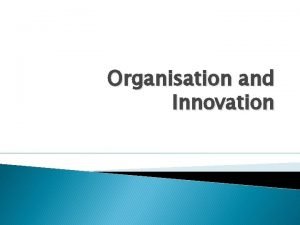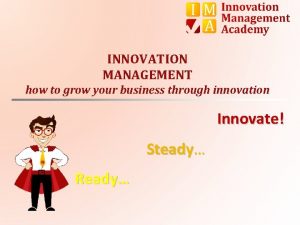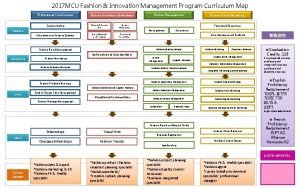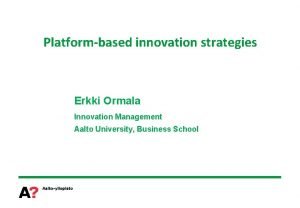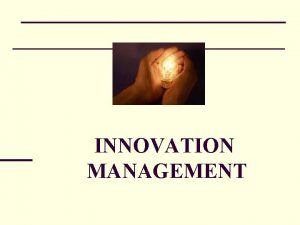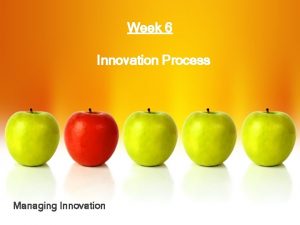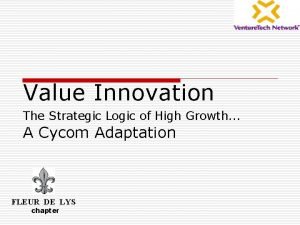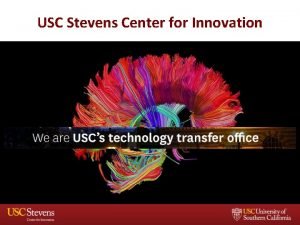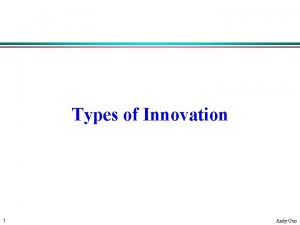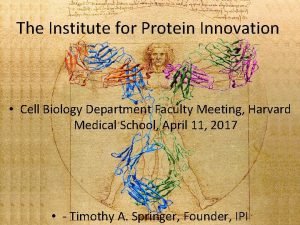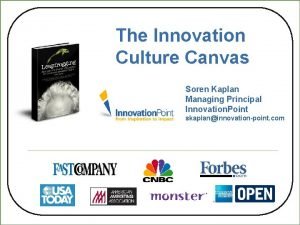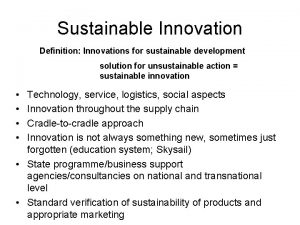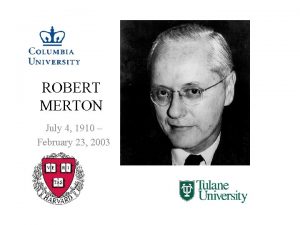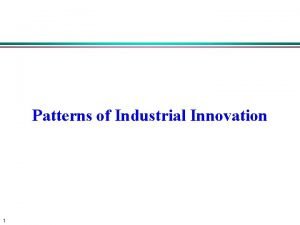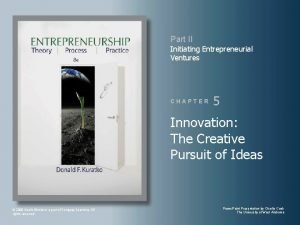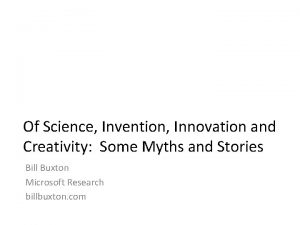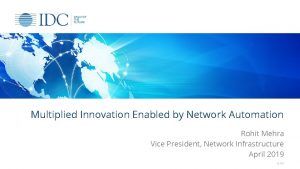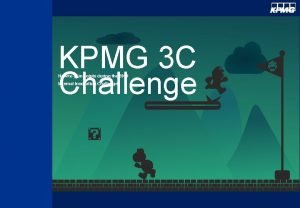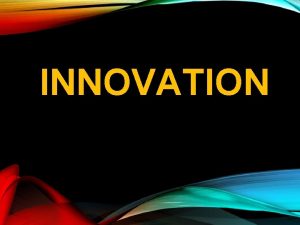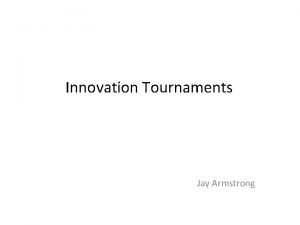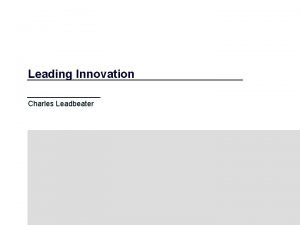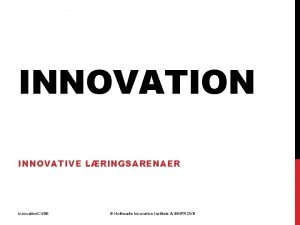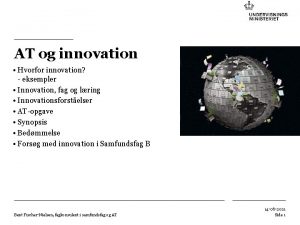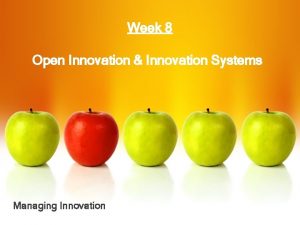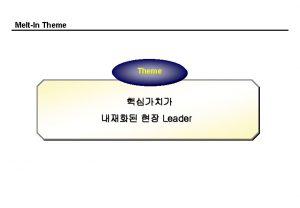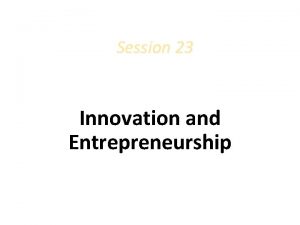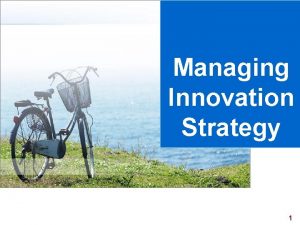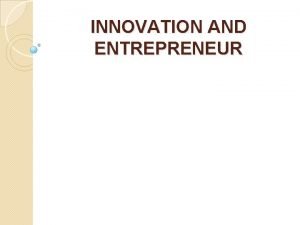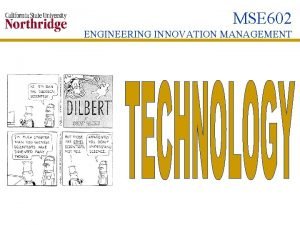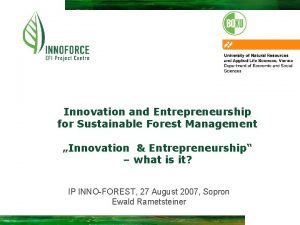INTRODUCTION TO INNOVATION MANAGEMENT What is innovation management





































- Slides: 37

INTRODUCTION TO INNOVATION MANAGEMENT

What is innovation management? • The role of innovation • What is innovation (definitions, typologies of innovation) • What is innovation management? • Models of the innovative process

Today’s contents • • The role of innovation What is innovation? What is innovation management? Models of the innovative process

Key Concepts in Innovation Management The aim of innovation. . . • Depends on the type of firm • Goal is mostly to survive, to grow, to make profit • R&D departments generally strive for the best technical solution. . . • . . . but what matters for innovation is how it influences survival chances, profit and growth opportunities!

Innovation and the corporate strategy Innovation management. . . • has to be understood as a core process of the organisation -> It is related to what is being produced • Is a long term race • Is about continuity • Has to deal with complexity!! • Is about being systematic developing routines around innovation

WHAT IS INNOVATION? • • Invention Technology Innovation Creating new or improved products, processes and services • Knowledge and learning • Uncertainty

Schumpeter’s distinction between ”Invention” and ”innovation” • An ’invention’ is an idea, a sketch or model for a new or improved device, product, process or system. It has not yet entered to economic system, and most inventions never do so. • An ’innovation’ is accomplished only with the first commercial transaction involving the new product, process, system or device. It is part of the economic system.

Dimensions of Innovation the ‘ 4 Ps’ of innovation – Product innovation: changes in the things (products or services) which an organization offers – Process innovation: changes in the ways in which they are created an delivered – Position innovation: changes in the context in which the product or services are introduced – Paradigm innovation: changes in the underlying mental modes which frame what an organization does

Figure 1. 1 Dimensions of innovation © 2005 Joe Tidd, John Bessant and Keith Pavitt

Triggers of discontinuity • • • New market emerges New technology emerges New political rules emerge Running out of road Change in market sentiment or behaviour Deregulation or reregulation Fractures along ’fault lines’ Unthinkable events Business model innovation Shifts in techno-economic paradigm Architectural innovation

Important contextual factors • • • Type of sector Size of firm The country and region The stage in the industry life cycle Political regulations

Abernathy & Utterback – industry life cycles • The fluid phase – co-existence of old and new technologies – rapid improvement of both →’the sailing ship effect’ – Target: What product and what market? – Technical: What product who will produce it ? – Experimentation

Important contextual factors • Globalisation • Sustainability • Networking organisation

• The transitional phase – A dominant design • Convergence around one design • Rolling bandwagon → innovation channeled around a core set of possibilities → a technological trajectory – Imitation and development • Reliability, cheaply, higher functionality, quality • The specific phase – Rationalization & scale economies – Differentiation through customization – Scope for innovation becomes smaller

Table 1. 2 Stages in innovation life cycle © 2005 Joe Tidd, John Bessant and Keith Pavitt

Three key questions 1. How do we structure the innovation process? 2. How do we develop effective routines? 3. How do we adapt or develop parallell routines to deal with incremental vs. discontinuous innovation?

Conclusions • • Different kind of innovations Context specific Innovation has different stages Knowledge is the key

So…. Innovation: • Depends on the type of firm, sector, industry life cycle, country and so on • Depends on the ”environment” • Goal is mostly to survive, to grow, to make profit • Technical solutions vs. societal and organisational aspects • Different from invention

Innovation management • Core process • Production • Commercialisation – design, marketing, resources, competence • Long term • Continuity • Complexity • Systematic, routines

First and second generation models First generation (50’s-60’s): Technology push “Linear model” R&D DESIGN & ENGINEERING MANUFACTURING MARKETING SALES Second generation (mid 60’s-70’s): Demand pull MARKET NEEDS MARKETING DEPT. R&D MANUFACTURING SALES

3 rd generation model

4 th generation model marketing R&D Product development Components manufacture Product manufacture

4 th generation model marketing R&D Product development Components manufacture Product manufacture Reduced time to market

5 TH generation model University Financial System Suppliers IP INDUSTRY IP Government R&T Centres IP Users

Innovation processes – generation model th 5 • Relevance of external sources of knowledge “firms do not innovate in isolation” • Related to Innovation System concept • Focus on networking • Still strong emphasis on R&D and formal knowledge (ICT)

6 th generation of innovation processes “Revolve around knowledge and learning” • Networks embrace all knowledge types, not only R&D. • Most innovative firm is the one that learns fastest • It is the use of knowledge that makes the competitive difference, and creates the advantage

Managing complexity product Radical R&D Network s Intellectu al Capital process es

Innovation can come: – From the market (demand pull - 2 nd) – From the “R&D department” (tech push - 1 st ) – From any department (interactive – 3 rd) – From process reinvention (integrated – 4 th) – From external sources of information (networks - 5 th) – From intangible assets (6 th)

Table 2. 2 Rothwell’s five generations of innovation models © 2005 Joe Tidd, John Bessant and Keith Pavitt

Innovation models SO, WHICH ONE IS RIGHT? • A fast food restaurant chain? • An electronic test equipment maker? • A hospital? • An insurance company? • A new entrant biotechnology firm?

Can we manage innovation? • The majority of failures are due to some weakness in the way the innovation process is managed. • Technical resources (people, equipment, knowledge, money, etc. ) • Capabilities in the organization to manage them

• Organizational routines or capabilities are “the way we do things around here (in this organization)” as a result of repetition and reinforcement • Routines are firm-specific and must be learned. • “To manage” innovation means to create an organisation where routines can be learned as to cope with the complexity and uncertainty of the innovation process • Unlearning is important


“Innovation is a risky process. . but also a mandatory one”. Success depends of a variety of: • Internal factors – – Good management Core competencies Clear innovation strategy Right technology • External factors – Links with market and suppliers – Learning from competitors – Institutional support: financing, human capital, etc

Table 2. 3 Problems of partial views of innovation

Table 2. 3 Problems of partial views of innovation (continued)

Successful innovation • New products, processes and services account for an increasing share of sales – Lower prices – Better-performing products – Better features for certain users (niche) • ½ of resources devoted to the development of new products go to unsuccessful projects • 35% of products launched fail commercially
 Mysite socccd
Mysite socccd Radical vs disruptive innovation
Radical vs disruptive innovation Introduction of innovation
Introduction of innovation Pearson’s uncertainty map
Pearson’s uncertainty map Oracle product lifecycle management cloud
Oracle product lifecycle management cloud Imitator pathfinder
Imitator pathfinder Fashion and innovation management
Fashion and innovation management New innovation management ab
New innovation management ab Innovation management
Innovation management What is innovation management
What is innovation management Essay structure
Essay structure Pyramid levels of management
Pyramid levels of management Top management middle management first line management
Top management middle management first line management Middle level management
Middle level management White space innovation
White space innovation Barriers to creativity
Barriers to creativity The innovation process
The innovation process Value innovation the strategic logic of high growth
Value innovation the strategic logic of high growth Utmaningsdriven innovation
Utmaningsdriven innovation Usc innovation
Usc innovation Fluid pattern
Fluid pattern Tradition vs innovation
Tradition vs innovation Institute of protein innovation
Institute of protein innovation Soren kaplan
Soren kaplan Sustainable innovation definition
Sustainable innovation definition Estonia innovation
Estonia innovation Clean energy smart manufacturing innovation institute
Clean energy smart manufacturing innovation institute Sap innovation award
Sap innovation award Sociological theory
Sociological theory Conformity; innovation; ritualism; retreatism; rebellion *
Conformity; innovation; ritualism; retreatism; rebellion * Estonia innovation
Estonia innovation Pattern of innovation
Pattern of innovation Eliminating muddling mindset
Eliminating muddling mindset Long nose of innovation
Long nose of innovation Automation
Automation Hamels wheel of innovation
Hamels wheel of innovation Kpmg innovation challenge
Kpmg innovation challenge Nordic innovation centre
Nordic innovation centre



